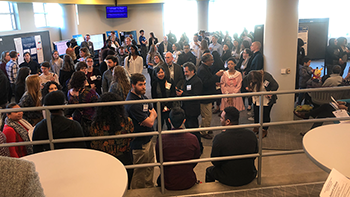Particle Trajectory Classification and Prediction Using Machine Learning
Description/Abstract/Artist Statement
Nuclear physics is a challenging scientific domain where experiments are often expensive due to the high cost of the machinery involved. Experimental setups record terabytes of data each day and process them to identify interacting particles from information provided by a series of detectors. One of the most important parts of data processing is identifying trajectories of charged particles in wire chambers. This process is computationally expensive and comprises about 94% of computational time. Charged particles are identified by combinatorically considering all possible combinations of segments. In this work, we used machine learning to identify possible valid combinations of track segments to reduce the number of combinatorics to be considered and reduced the computational time by a factor of ~6 times.
We developed three different models to address this problem: an extremely randomized trees model, a multi-layer perceptron as well as a convolutional neural network (CNN). The models achieved an overall classification accuracy of 96.5%. To further reduce the search space for classification, we developed a supervised recurrent neural network (RNN) using long short-term memory (LSTM) layers capable of predicting particle trajectories based on previous trajectory information. Because the model is trained on only acceptable trajectories (i.e. broken lines), it will help eliminate many unacceptable trajectories that do not align with its predictions. These machine learning models will be employed in the experimental pipeline for the CLAS12 detector in order to filter incoming data, save 6-8x more time and energy compared to current methods used, and help increase experimental accuracy.
Faculty Advisor/Mentor
Nikos Chrisochoides
Presentation Type
Poster
Disciplines
Nuclear | Numerical Analysis and Scientific Computing | Theory and Algorithms
Session Title
Poster Session
Location
Learning Commons, Atrium
Start Date
2-8-2020 8:00 AM
End Date
2-8-2020 12:30 PM
Particle Trajectory Classification and Prediction Using Machine Learning
Learning Commons, Atrium
Nuclear physics is a challenging scientific domain where experiments are often expensive due to the high cost of the machinery involved. Experimental setups record terabytes of data each day and process them to identify interacting particles from information provided by a series of detectors. One of the most important parts of data processing is identifying trajectories of charged particles in wire chambers. This process is computationally expensive and comprises about 94% of computational time. Charged particles are identified by combinatorically considering all possible combinations of segments. In this work, we used machine learning to identify possible valid combinations of track segments to reduce the number of combinatorics to be considered and reduced the computational time by a factor of ~6 times.
We developed three different models to address this problem: an extremely randomized trees model, a multi-layer perceptron as well as a convolutional neural network (CNN). The models achieved an overall classification accuracy of 96.5%. To further reduce the search space for classification, we developed a supervised recurrent neural network (RNN) using long short-term memory (LSTM) layers capable of predicting particle trajectories based on previous trajectory information. Because the model is trained on only acceptable trajectories (i.e. broken lines), it will help eliminate many unacceptable trajectories that do not align with its predictions. These machine learning models will be employed in the experimental pipeline for the CLAS12 detector in order to filter incoming data, save 6-8x more time and energy compared to current methods used, and help increase experimental accuracy.


